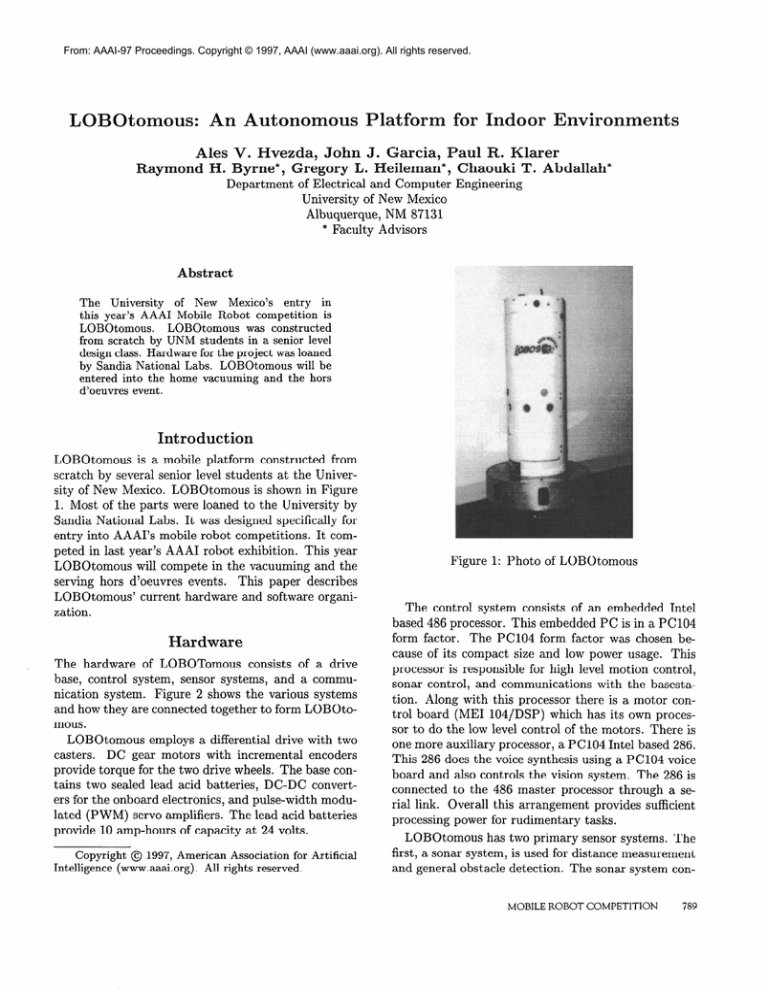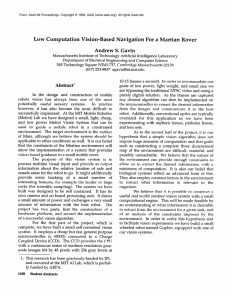
From: AAAI-97 Proceedings. Copyright © 1997, AAAI (www.aaai.org). All rights reserved.
LOBOtomous:
An Autonomous
Platfor
for Indoor
Ales V. Hvezda, John J. Garcia, Paul R. Klarer
Raymond
Chaouki T. Abdallah*
H. Byrne*, Gregory E. Heileman*,
Department of Electrical and Computer Engineering
University of New Mexico
Albuquerque, NM 87131
* Faculty Advisors
Abstract
The University of New Mexico’s entry in
this year’s AAAI Mobile Robot competition is
LOBOtomous.
LOBOtomous was constructed
from scratch by UNM students in a senior level
design class. Hardware for the project was loaned
by Sandia National Labs. LOBOtomous will be
entered into the home vacuuming and the hors
d’oeuvres event.
Introduction
LOBOtomous is a mobile platform constructed from
scratch by several senior level students at the University of New Mexico. LOBOtomous is shown in Figure
1. Most of the parts were loaned to the University by
Sandia National Labs. It was designed specifically for
entry into AAAI’s mobile robot competitions. It competed in last year’s AAAI robot exhibition. This year
LOBOtomous will compete in the vacuuming and the
serving hors d’oeuvres events. This paper describes
LOBOtomous’ current hardware and software organization
Hardware
The hardware of LOBOTomous consists of a drive
base, control system, sensor systems, and a communication system. Figure 2 shows the various systems
and how they are connected together to form LOBOtomous.
LOBOtomous employs a differential drive with two
casters. DC gear motors with incremental encoders
provide torque for the two drive wheels. The base contains two sealed lead acid batteries, DC-DC converters for the onboard electronics, and pulse-width modulated (PWM) servo amplifiers. The lead acid batteries
provide 10 amp-hours of capacity at 24 volts.
Copyright @ 1997, American Association for Artificial
Intelligence (www.aaai.org). All rights reserved.
Figure 1: Photo of LOBOtomous
The control system consists of an embedded Intel
based 486 processor. This embedded PC is in a PC104
form factor. The PC104 form factor was chosen because of its compact size and low power usage. This
processor is responsible for high level motion control,
sonar control, and communications with the basestation. Along with this processor there is a motor control board (MEI 104/DSP) which has its own processor to do the low level control of the motors. There is
one more auxiliary processor, a PC104 Intel based 286.
This 286 does the voice synthesis using a PC104 voice
board and also controls the vision system. The 286 is
connected to the 486 master processor through a serial link. Overall this arrangement provides sufficient
processing power for rudimentary tasks.
LOBOtomous has two primary sensor systems. The
first, a sonar system, is used for distance measurement
and general obstacle detection. The sonar system conMOBILE ROBOT COMPETITION
789
Sonar
Tranducers
Intelligence
Task
I
Al
Task Scheduler
I
High Level
Tasks
Low Level
Tasks
Hardware
Tasks
(A--]
[GAY)
[G-G)
(G-j
(Voice)
[FE
Figure 3: Software Organization
Software
Figure 2: Hardware Organization
sists of a single Polaroid development board, a multiplexing board, and twenty ultrasonic transducers. The
Polaroid board fires an individual ultrasonic tranducer,
waits for the return pulse, and then calculates the distance.
The ultrasonic tranducer that is to be fired
next is selected by a multiplexing board. The twenty
ultrasonic transducers are arranged around the robot
to provide sufficient detection of objects and obstacles.
The second sensor system is the vision system. The
vision system consists of a Connectix QuickCam which
is connected to the 286 through a parallel port. This
particular camera was chosen because of its affordability. As mentioned previously the 286 is connected to
the 486 master processor through a serial link. This
link does not provide much bandwidth, so all image
processing is done on the 286 with results of the processing being sent back the master processor. These
two systems together gather sufficient information to
allow LOBOtomous to navigate through an indoor environment.
Finally, for communication
with a basestation,
LOBOtomous is equipped with a 9600 baud frequency
hoping radio modem. This modem is used to send status and navigation data to a basestation. The basestation is responsible for monitoring the robot and ensuring that all systems are functioning properly. A
secondary responsibility of the basestation is to gather
data on the operation of the robot for further study.
The basestation is a Intel based PC running Linux.
Linux, the freely available UNIX operating system, was
chosen because of its rich development environment.
790
MOBILE ROBOT COMPETITION
There are currently two different implementations of
the software which runs on LOBOtomous. Both share
a common architecture which is shown in Figure 3.
This architecture breaks the work down into distinct
tasks which are organized in a hierarchical manner. At
the highest level is the intelligence or scheduler task
which is the brain of LOBOtomous.
This task is responsible for all decisions relating to the current work
the robot is trying to accomplish. The next level contains the high level behavior tasks. This level consists
of path creation, map maintenance, and communication with the basestation. Next, the low level behavior layer, consists of tasks such as wall following, path
following, collision avoidance, door traversal, and creating the protocol packets for communicating with the
basestation.
The final layer, the low level hardware
layer consists of tasks which interact directly with the
hardware. The motion control, dead reckoning, sonar
control, voice synthesis, modem communications, and
the vision tasks reside in this layer. This organization
provides a clear and simple view of how the software
is organized on LOBOtomous.
The first implementation of LOBOtomous’ software
was done using the AMX real-time operating system
library. AMX provided all of the necessary support
code for real-time tasks. This implementation was was
used in last years AAAI robot exhibition.
The second implementation of LOBOtomous’ software was done using custom routines which implement
a rudimentary real-time operating system. This implementation is far simpler than the AMX version, and is
much easier to understand and maintain.
This implementation is being actively developed on LOBOtomous.







